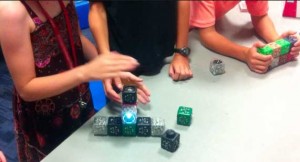Need inspiration for some fun, STEM projects to do at home? Check out the new YouTube series “Make with me”! Join the Modular Robotics staff as we try out fun, challenging, robot activities that we can do around the house, like building this Hand Washing Timer robot:
Of course STEM at Home doesn’t need to be involved projects! Kids can learn a lot about robotics just by building their own Cubelets racing robots.
Whether it’s harnessing creativity by building robot seascapes with LEGO or figuring out how to code a Toilet Paper Ration Robot in Blockly, the “Make with me” videos have something for everyone.
Check it the whole playlist on YouTube and don’t forget to subscribe so you never miss a new video!
Tag Archives: Creativity
As we incorporate STEAM opportunities into our classrooms, there are many different ways to scaffold an activity to meet our needs. Some projects lend themselves to student design from the very beginning, and others lend themselves to students solving a problem we’ve identified for them (like designing a maze-solving robot or a robot to help the blind). This balance is integral to exposing students to every step of the design process while also making sure we have time to address all the standards we need to cover.
But student motivation is a major factor in how efficiently we can work through material each year. One way to increase student motivation is to put students in the driver’s seat earlier, by introducing subjects with creative hooks and giving students the space to define the projects according to their understanding.
Every project students do requires a discussion of the criteria and constraints. Whether those are teacher-given or student-provided, criteria and constraints indicate how students will be assessed on their design.
Criteria are the requirements for a project. If any of the criteria are missing, then the design is incomplete.
Constraints are the limitations for a project. What will students not have access to? For instance, are there considerations about price, location, or size? Continue reading
Michael Jaber has seen first-hand the profound effect Cubelets robot blocks have on students. Students who tended to sit back now step up and lead; those who were shy are now willing participants. Those who previously had no interest in STEM have joined the STEAM Team at Jefferson Elementary School in Sheboygan, WI.
Mr. Jaber is the Coordinator of Instructional Technology. Every Thursday afternoon, he spends time in classrooms showing students new technology gadgets. As one of the featured gadgets, Cubelets have piqued the interest of all the students. Cubelets are used to explore robotics using a constructivist approach, and Mr. Jaber has seen teacher Diane Moon successfully use them in the Next Generation Science Standards fifth-grade curriculum.
When Jefferson Elementary first received Cubelets, they used them in a technology center rotation to allow students to explore and determine what the function of each robot block was This lead to purposeful conversations and the students worked together to create the specific robot construction that they had in mind.
Continue reading
As Space Shuttle Endeavor is transported to its retirement, my Facebook and Twitter feeds are flooded with comments and photos of its final flight. I can’t help but feel like this is, at some level, the end of an era. An era of big dreams and phenomenal achievements. An era of curiosity, exploration and discovery. It’s the end of an era of great things.

 I’m helping organize the Creativity & Cognition conference. It’s an interesting mix of artists, computer scientists, and just plain creative people. Which leads to the question: How do kids learn to be creative? To create is to make; so learning to make things is an important part of learning creativity. Construction kits like Lego and Meccano offer a structured (“scaffolded”) way to make physical things; and programming languages like Seymour Papert’s Logo and Alan Kay’s Squeak have offered kids a way to make computational things. Now we’re amidst a revolution that brings together the physical and computational in massively parallel and distributed ways. So, we need construction kits to scaffold kids creativity in this new world.
I’m helping organize the Creativity & Cognition conference. It’s an interesting mix of artists, computer scientists, and just plain creative people. Which leads to the question: How do kids learn to be creative? To create is to make; so learning to make things is an important part of learning creativity. Construction kits like Lego and Meccano offer a structured (“scaffolded”) way to make physical things; and programming languages like Seymour Papert’s Logo and Alan Kay’s Squeak have offered kids a way to make computational things. Now we’re amidst a revolution that brings together the physical and computational in massively parallel and distributed ways. So, we need construction kits to scaffold kids creativity in this new world. 
